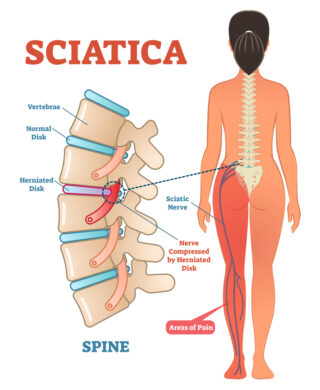
Synergy Spine and Pain Center
12150 Annapolis Road
Suite #209
Glenn Dale, MD 20769
Synergy Spine and Pain Center
10709 Indian Head Hwy MD-210
Suite D
Fort Washington, MD 20744
Synergy Spine and Pain Center
11233 Lockwood Drive
Silver Spring, MD 20901

More Pain Management & Rehabilitation Articles
Sciatica Treatment Options

The sciatic nerve is the largest single nerve in the human body; it runs from each side of the lower spine through deep in the buttock into the back of the thigh and all the way down to the foot. It serves a vital role in connecting the spinal cord with the leg and foot muscles.
Sciatica is nerve pain from irritation of the sciatic nerve. Sciatica pain is typically felt from the low back to behind the thigh and radiating down below the knee. Treatments for sciatica depend on the underlying cause and the severity of the pain.
For severe or ongoing flare-ups of sciatic nerve pain, the condition may need to be treated so it does not get worse over time.
Readily available non-surgical remedies and regular exercise will go a long way toward relieving the pain most people experience.
For others, when the pain is severe or does not get better on its own, a more structured treatment approach, and possibly surgery, may be the best option for finding pain relief and preventing or minimizing future pain and/or dysfunction.
Non-surgical Treatment for Sciatica
The goals of non-surgical sciatica treatments are to relieve pain and any neurological symptoms caused by a compressed nerve root. There is a broad range of options available for sciatica treatment. One or more of the treatments below are usually recommended in conjunction with specific exercises.
Heat/Ice
For acute sciatic pain, heat and/or ice packs are readily available and can help alleviate the leg pain, especially in the initial phase. Usually ice or heat is applied for approximately 20 minutes, and repeated every two hours. Most people use ice first, but some find more relief with heat. The two may be alternated. It is best to apply ice with a cloth or towel placed between the ice and skin to avoid an ice burn.
Pain Medications
Over-the-counter or prescription medications are often effective in reducing or relieving sciatica pain. Nonsteroidal anti-inflammatory drugs (such as ibuprofen or naproxen), or oral steroids can reduce the inflammation that is usually part of the cause of pain. Muscle relaxants or narcotic medications may also be prescribed for the short term (a few days and up to two weeks) to alleviate pain.
Epidural Steroid Injections
If the pain is severe, an epidural steroid injection can reduce inflammation. Unlike oral medications, an injection goes directly into the painful area around the sciatic nerve to address the inflammation that may be causing pain.
While the effects tend to be temporary (providing pain relief for as little as one week or up to a year), and it does not work for everyone, an epidural steroid injection can be effective in relieving acute sciatic pain. Importantly, it can provide sufficient relief to allow a patient to progress with a conditioning and exercise program.
It is always advisable to have a qualified medical professional oversee any type of sciatica treatment.
Other Articles You May Find of Interest...
- Alleviating Joint Pain in Pets: A Comprehensive Guide
- Sciatica Treatment Options
- How to Promote Bone Fracture Healing? Tips for Faster Healing
- Managing Chronic Back and Neck Pain
- Pervasiveness Of Pain
- Effective Solutions for Lower Back Arthritis: Medial Branch Blocks and Radiofrequency Ablation
- Spinal Compression Fracture Treatment Options

















